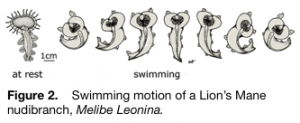
At the Catalina Island Marine Institute, we are all about being active and on the move. The same goes for the invertebrates in our labs! But how do they move? Magic? Super powers? Thinking happy thoughts? Actually, we can explain with…..science!
 Some of the animals in our lab move by using their little tube feet. These are animals like the sea stars, sea cucumbers, and urchins, which are all members of the phylum Echinodermata. Echinodermata translates to “spiny skin”. Not only do the members of this phylum have spines, they also have sticky little feet! In fact, if you look underneath any of these animals, you will see what looks like little tubes with suction cups on the ends. The animal will extend these tube feet in the direction it wants to go, suction on, and then pull itself along. Sometimes the tube feet can also be used as levers and for food capture. The tube feet can also be used to help the animal stay in place, if say, kids—I mean… “seagulls”—..were trying to grab at them! So cool.
Some of the animals in our lab move by using their little tube feet. These are animals like the sea stars, sea cucumbers, and urchins, which are all members of the phylum Echinodermata. Echinodermata translates to “spiny skin”. Not only do the members of this phylum have spines, they also have sticky little feet! In fact, if you look underneath any of these animals, you will see what looks like little tubes with suction cups on the ends. The animal will extend these tube feet in the direction it wants to go, suction on, and then pull itself along. Sometimes the tube feet can also be used as levers and for food capture. The tube feet can also be used to help the animal stay in place, if say, kids—I mean… “seagulls”—..were trying to grab at them! So cool.
Some of the friends in our Mollusk tank, such as the California Sea Hare, Aplysia californica, and the Spanish Shawl nudibranch, Flabellina iodinea, move in a different way. These animals have a soft slug-like body, the length of which is called a “foot”. Weird, I know, imagine if your whole body was called a foot! So the foot produces slime and when the animal contracts its muscles and moves tiny hairs on its body through the slime it manages to scoot, scoot, scoot!
 As if this wasn’t enough, many of the slugs can also swim (Fig.2) The Spanish Shawl and the Lion’s Mane, Melibe leonina, can swim by whipping their head back and forth towards the end of their foot. It can be an effective way to respond to predators, and kind of looks like they are throwing down for a dance off.
As if this wasn’t enough, many of the slugs can also swim (Fig.2) The Spanish Shawl and the Lion’s Mane, Melibe leonina, can swim by whipping their head back and forth towards the end of their foot. It can be an effective way to respond to predators, and kind of looks like they are throwing down for a dance off.
The take away here is that there are many ways to move through life, and invertebrates are great role models for showing us how it’s done! There’s no right or wrong way, whether you have many sticky feet, a whole body called a foot to scoot around on slime with, or maybe you just whip back and forth—- no kind of motion is too “loco” to be in the ocean!
https://www.britannica.com/animal/echinoderm
http://www.divedownbelow.com/marine-biology/nudibranchia-marine-biology/
http://pacificabeachcoalition.org/sea-stars/tube-feet-of-spiny-starfish-borut-furlan-getty/


